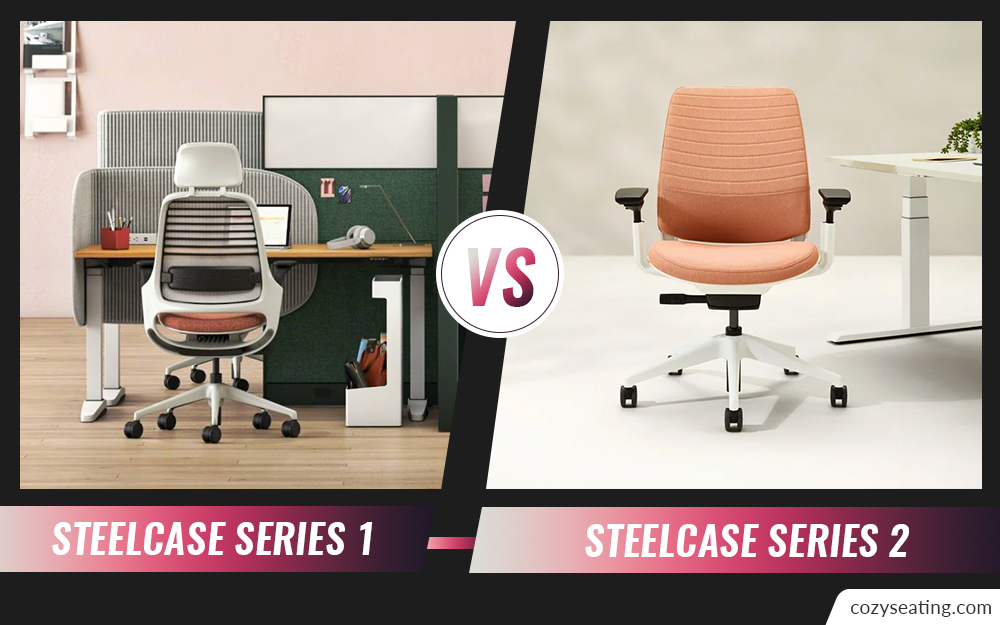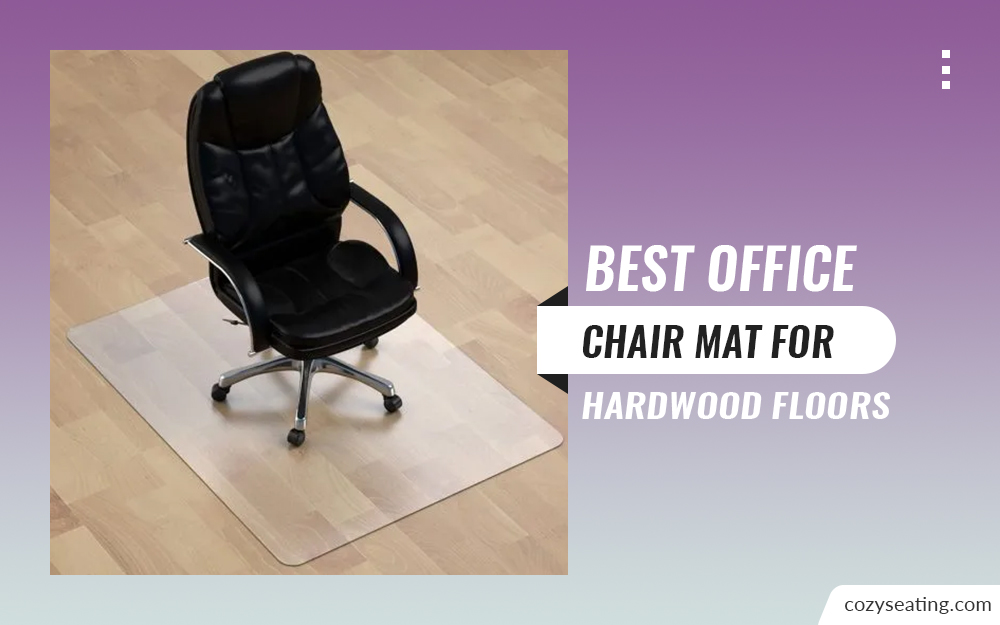
Disclosure: This site is reader-supported & contains affiliate links. We may earn a commission through products purchased using links on this page. Learn more

Besides leaving you with a dire need for a back massage at the day’s end, an awkward sitting position may lead to long-lasting damage.
Having an ergonomic office chair and aligning it gives you a suitable working posture, enhances your concentration, and improves your productivity.
Below, I’m going to show you how to adjust the office chair seat angle.
You adjust the angle of a chair seat by pushing your lever inwards or outwards. An office chair should be tilted forward to lower back pain and ensure better blood flow. Sometimes, your office chair doesn’t lean back anymore due to peak lever tension, a faulty lever, or a faulty spring.
Table of Contents
How Do You Adjust the Angle of a Chair Seat?
Your chair’s tilt mechanism has several different adjustments. It allows you to go up and down and lock the chair in the upright position so that you can’t tilt back.
Also, it permits tilting while adjusting your angle and the tension taken to lean back.
It’s pretty straightforward to determine whether you have a swivel tilt mechanism. To establish this, check under your seat pad (the part you sit on). You should see a large adjustment knob; most chairs have this part recessed.
There is also usually a single adjustment lever on the right-hand side of the chair.
So how do you adjust your office chair’s angle?
1. Adjusting the Tilt Lock
Swivel/tilt chairs typically lock in the upright position. Your seat height adjustment lever usually serves two purposes. It goes in and out and also twists when you heed to adjust your height.
When you pull your seat height adjustment lever outwards, it releases, allowing you to lean backward. When you press the lever inwards, it won’t tilt.
However, there is always a slight movement in the chair, but it prevents you from going all the way back.
2. Tilt Tension Adjustment
The tilt tension adjustment is one of the most crucial settings to ensure your chair is operating correctly. This setting determines how much your chair rocks when you tilt it.
To adjust your office chair’s tilt tension, use the knob underneath your seat pad. If you flip the chair, you’ll see a plus and minus sign that directs you on how to turn the knob.
When the chair is not tilting, it should be at the end. Begin turning the knob towards the minus sign. Be prepared to turn it for quite some time before you get it to the lowest tension setting.
At its most loose point, your office chair shouldn’t take much effort to lean back.
Why Does My Office Chair Not Lean Back Anymore?
The older your office seat gets, the more pressure it handles, and the likelihood of it failing to recline increases.
You might get frustrated when you get a chair because you may release the tilt lock and lean backward, but it fails to tilt.
Failure to lean even with the lever set to the required position is because the tilt tension adjustment is as tight as it can go.
Usually, chairs ship with the tilt tension at the maximum setting. If you sit in the office chair unsuspectingly, you are likely to go backward.
If you have an office chair with a motorized tilting function, it is best to seek expert repair.
Doing it yourself may lead to damaging your reclining function entirely, forcing you to replace some parts. You can adjust a manually-reclining office chair yourself.
How Do You Adjust an Office Chair That Won’t Lean Back?
Before starting the repair, determine the issue with your office chair. Trying to repair the seat before analyzing the problem may waste your time and potentially destroy your seat’s tilting mechanism.
Sit on your office chair and adjust the lever to check the degree of adjustment. If it’s not reclining at all, your tension lever is likely to be set at maximum level.
Adjust it using the above procedure.
If your lever has an issue, it may fail to lock on any position, or you may not be able to pull it outwards to enable your chair to tilt. In this case, you may need to get a lever lock replacement.
Zero tension once you unlock your tilt lever may mean you have a dysfunctional or disengaged spring.
Replace/Repair the Tilt Lever
Does your tilt lever stay in one position irrespective of how you move it? Is it loose even in the lock position?
If your tilt lever is acting in any of these two ways, you should disassemble your office chair and have a look at it.
Position your chair upside down and remove the bolts. Once you remove the chair from the cylinder and its base, you should access the mechanism with ease.
If your tilt lever has a bend or breakage, you will have to get a replacement. If the lever’s only issue is being out of position, realign it with a large screwdriver or your hands.
Ensure you oil the mechanical parts adequately before attaching your gas cylinder and base back to your seat.
Recliner Spring Replacement
A tilting office chair comes with either a radial spring or linear spring to prevent sudden adjustments when setting your tilt angle.
If there is no tension when tilting your chair, the issue is with your chair’s spring. You’ll need to remove your chair’s top compartment, to easily access the spring.
If you notice breakage in your spring, acquire a replacement. On the other hand, your spring may be out of position, and you’ll only need to put it back in place.
More? Check out this article on recliner spring replacement.
Why Is My Office Chair Leaning Forward?
The forward tilt mechanism alters your office chair’s angle allowing it to recline up and down. The feature lowers back pressure, allows proper blood flow in the lower part of the body, and ensures you get an appropriate sitting posture.
However, excessive forward tilting may lead to health issues and arises due to:
- A loose forward tilt knob
- Your tilt knob getting stuck
- Dislodged or destroyed tilt knob
Fix the loose tension lever by tightening it at minimum tension.
For a stuck knob, detach your chair from the base with a screwdriver. Access the lever that connects to your tilt knob.
Apply WD40 or another grease oil on it to remove grime and rust. Tighten it and recheck.
When it comes to a dislodged tilt knob, you can open the back of your chair and reposition it. A damaged knob needs replacement.
Should Office Chair Be Tilted?
Some people misunderstand the importance of forward-tilt functionality. Nevertheless, when not overdone, this mechanism is an excellent inclusion into some chairs that give several benefits.
For instance, proper blood distribution, reduced back pain, and good posture.
Proper Blood Distribution
If you fail to align your office chair to suit your sitting habits and physique, you may end up constricting blood flow to your legs.
Inadequate blood circulation can result in numbness, tingling, and sometimes pain. Moreover, reducing blood flow to your legs may lead to stiffening and cramping of muscles.
Forward tilting allows you to distribute pressure better to your body’s lower parts. It also ensures you position your feet firmly and properly on the ground.
This way, you allow better blood circulation in your legs and adequate comfort that can better your concentration on your tasks.
Proper Posture
Proper posture is essential when sitting as it is while you stand. A forward-tilting chair may help you adopt a better sitting position while working and even when you end your day.
Sitting on a non-aligned chair may result in muscle tightening, hampering your ability to move your body with ease. It may also result in weaker back and core muscles.
This way, you may end up slumping or sitting in a poor posture that may injure and cause you pain.
Reduced Back Pain (Lumbago)
Lower back pain occurs due to issues with your lower spine. Injuring your back muscles that may occur due to improper sitting posture can result in stress on your spinal column and muscles.
Lumbago may also lead to your back, leg, and hips being in pain. Leg numbness can result in pain while walking. You may also experience muscle spasms.
Forward tilting allows you to minimize pressure on your back, reducing spinal stress.
Frequently Asked Questions
What Is the Best Angle for a Chair Back?
The best angle for a chair back is a right angle or more to give you adequate comfort. Additionally, your lower back requires proper support as you work. Your upper back should lean back, while your lower back should align forward to ensure you don’t strain.
How Do You Adjust a Chair Ergonomically?
You adjust your chair ergonomically by setting your backrest at 90 degrees. Set your chair height correctly to ensure your feet touch the ground at a right angle.
Conclusion
Often, adjusting your office chair’s angle is as simple as pulling out your tilt lever. But if your chair fails to recline, you can realign your knob.
Alternatively, adjust your tension, or replace the lever in severe cases.
Recommended Reading

Steelcase Series 1 Vs. Series 2 : Which Is the Better Option?
Steelcase Series 1 vs. Series 2! Explore our detailed comparison of the two ergonomic office chairs and choose the ideal one for a fantastic sitting experience.

The 10 Best Office Chairs Under $150 in 2022
Are you searching for a chair but not willing to spend more than $150? Here, we've got the best office chairs under $150. Enter to explore more.

7 Best Office Chair Mat for Hardwood Floors
Finding the best office chair mat for hardwood floors is no easy task. Please read on for tips on finding an ideal rug for your office.

10 Best Office Chair with 400 lb Weight Capacity
Are you looking for 400 lb office chair? We have reviewed the best office chair with 400 lb weight capacity. Enter to learn more.
